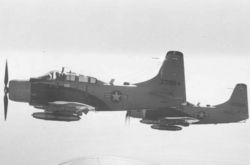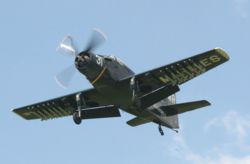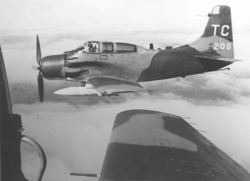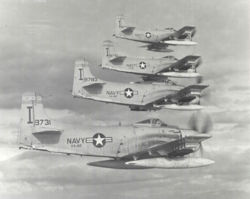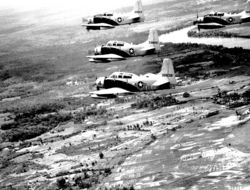PlaneSpottingWorld welcomes all new members! Please gives your ideas at the Terminal.
A-1 Skyraider
| AD (A-1) Skyraider | |
|---|---|
| U.S. Navy Skyraider from Attack Squadron Fifteen (VA-15) catches a wire during carrier operations. | |
| Type | Attack aircraft |
| Manufacturer | Douglas Aircraft Company |
| Maiden flight | 1945-03-18 |
| Introduced | 1950s |
| Retired | 1970s |
| Primary users | United States Air Force United States Navy |
| Produced | 1945–1957 |
| Number built | 3,180 |
The Douglas A-1 (formerly AD) Skyraider was a U.S. single-seat attack bomber of the 1950s, 1960s and early 1970s. A propeller-driven anachronism in the jet age, the Skyraider had a remarkably long and successful career well into the space age, and inspiring a straight-winged slow flying jet powered successor which is still in front line service today.
It carried various nicknames including "Spad" (a model of airplane flown in World War I); Able Dog (phonetic AD); the Destroyer; Hobo (radio call sign of the USAF 1st Air Commando/Special operations Squadron); Firefly (602nd ACS/SOS); Zorro (22nd SOS); The Big Gun; Old Faithful; Old Miscellaneous; Fat Face (AD-5/A-1E version, side-by-side seating); Guppy (AD-5W version); Q-Bird (AD-1Q/AD-5Q versions); Flying Dumptruck (A-1E); Sandy (Combat Search And Rescue helicopter escort); Crazy Water Buffalo (South Vietnamese nickname).
Contents
Development
The A-1 was originally designed to meet World War II requirements for a carrier-based, single-place, long-range, high performance dive-/torpedo bomber. Designed by Ed Heinemann of the Douglas Aircraft Company, the Skyraider was ordered in July 1944 as the XBT2D-1. In April 1945, one month after its first flight on 18 March 1945, it was evaluated at the Naval Air Test Center (NATC), and December 1946, after redesignated to AD-1, delivery of the first AD to fleet squadron was made to VA-19A.
The low-wing monoplane design started with a Wright R-3350 radial engine, later upgraded multiple times. Its distinctive feature was the presence of seven hardpoints on each wing. The large straight wing give it excellent low speed maneuverabiity, and enable it to carry a tremendous amount of ordnance over a considerable combat radius and loiter time for its size, comparable to much heavier subsonic or supersonic jets. The aircraft is optimized for the ground-attack mission, and is armoured against ground fire in key locations, unlike faster fighters adapted to carry bombs such as the F4U Corsair or P-51 Mustang which would be retired by US forces long before the 1960s.
The piston engined prop-driven Skyraider was a post-war follow-on to WWII dive bombers and torpedo bombers such as the Helldiver and Avenger. It was replaced in the 1960s by the A-4 Skyhawk as the Navy's primary light attack plane. Used over Korea and briefly over North Vietnam, it was adopted as the primary ground support attack for the US Air Force and South Vietnamese VNAF during the Vietnam war, before being supplanted by the jet powered A-37 Dragonfly and A-7 Corsair II.
Service
Korea
Though the Skyraider was produced too late to take part in World War II, it became the backbone of U.S. Navy aircraft carrier and United States Marine Corps (USMC) strike aircraft sorties in Korean War, with the first ADs going into action from the USS Valley Forge.[citation needed] Its ability to employ a wide variety of weapons allowed it to be used against nearly all Korean targets, earning the Skyraider the reputation of the most effective close air support aircraft in the world at the time.[citation needed] Its weapon load and 10-hour flying time far surpassed the jets that were available at the time.[citation needed][citation needed] On 16 June 1953, a USMC AD-4 from VMC-1 piloted by Major George H. Linnemeier and CWO Vernon S. Kramer shot down a Soviet-built Polikarpov Po-2 biplane, the only documented Skyraider air victory of the war.[1] During the Korean War (1950-1953) A-1 Skyraiders were flown only by the US Navy and US Marine Corps, and were normally painted in dark navy blue. A total of 101 Navy and Marine AD Skyraiders were lost in combat during the Korean War, and 27 were lost to operational causes, for a total loss of 128 Skyraiders in the Korean War.
Vietnam
Although the carrier air wing was rapidly transitioning to jet aircraft, the A-1 Skyraider was still the medium attack aircraft in many air wings in 1965 with the A-6A Intruder slated to replace it. Skyraiders participated in the first strikes against North Vietnam, but were eventually replaced by Intruders. U.S. Navy Skyraiders shot down two Soviet-built Mikoyan-Gurevich MiG-17 jet fighters during the war—on 21 June 1966 by LT Clinton B. Johnson and LTJG Charles W. Hartman III (shared victory) of VA-25, and on 9 October 1966 by LTJG William T. Patton of VA-176.[1] As they were released from Navy service, Skyraiders were introduced into the South Vietnamese Air Force (VNAF) and adopted by the USAF as one of the Skyraider's most famous roles as the "Sandy" helicopter escort. [citation needed] USAF Major Bernard F. Fisher piloted an A-1E on the March 10, 1966 mission for which he was awarded the Medal of Honor for rescuing Major "Jump" Myers at A Shau Special Forces Camp.[citation needed]USAF Lieutenant Colonel William A.Jones, III piloted an A-1H on the September 1 1968 mission for which he was awarded the Medal of Honor. In that mission, despite significant damage to his aircraft and suffering serious burns, he returned to his base and reported the position of a downed flight crew member.[citation needed] After November 1972, all A-1s in US service in Southeast Asia were transferred to the South Vietnamese Air Force (VNAF) and their former roles were taken over by the subsonic A-37 Dragonfly and A-7 Corsair II.[citation needed] The Skyraider in Vietnam pioneered the concept of tough, survivable aircraft with long loiter times and large ordnance loads. The USAF lost 201 Skyraiders to all causes in Southeast Asia, while the Navy lost 65 to all causes. Of the 266 lost A-1's, 5 were shot down by surface to air missiles (SAMs), and 3 were shot down in air to air combat; two by North Vietnamese Mig-17's. The first A-1 was shot down on 29 April 1966, and the second A-1 was lost on 19 April 1967; both were from the 602 Air Commando Squadron (ACS). The third A-1 Skyraider was from Squadron VA-35 and was lost to a Red Chinese Mig-19 (J-6) on 14 February 1968. LTJG Joseph P. Dunn (USN), had flown too close to the Communist Chinese held island of Hainan, and had been intercepted. Lieutenant Dunn's A-1 Skyraider was the last US Navy A-1 lost in the war, and he did not survive. Shortly thereafter, A-1 Skyraider naval squadron's transitioned to A-4 Skyhawks. [3]
In contrast to the Korean War, fought a decade earlier, the US Air Force, in Vietnam, utilized the naval A-1 Skyraider for the first time. As the Vietnam war progressed, USAF A-l's were painted in camouflage, while USN A-1 Skyraiders were grey/white in color; again, in contrast to the Korean War, when A-1's were painted dark blue.
In 1965, to highlight the dropping of the 6 millionth pound of ordnance; CDR Clarence J. Stoddard, flying an A-1H, dropped a special, one time only, object in addition to his other munitions. It was a (no longer working) clean toilet. [1]
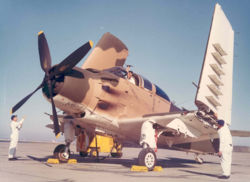
Adaptability
In addition to serving during Korea and Vietnam as an attack aircraft, it was modified into a carrier-based airborne early warning aircraft, replacing the Grumman TBM-3W Avenger. It served in this function in the USN and Royal Navy, being replaced by the E-1 Tracer and Fairey Gannet respectively in those services.[citation needed]
Production and variants
Production ended in 1957 with a total of 3,180 built. However, in 1962 the existing Skyraiders were redesignated A-1D through A-1J and later used by both the USAF and the Navy in the Vietnam War.
The Skyraider went through seven versions, starting with the AD-1, then AD-2 and AD-3 with various minor improvements, then the AD-4 with a more powerful R-3350-26WA engine. The AD-5 was significantly widened, allowing two crew to sit side-by-side (this was not the first multiple-crew variant, the AD-1Q being a two-seater and the AD-3N a three-seater); it also came in a four-seat night-attack version, the AD-5N. The AD-6 was an improved AD-4B with improved low-level bombing equipment, and the final production version AD-7 was upgraded to a R-3350-26WB engine.
- XBT2D-1: Single-seat dive-bomber, torpedo-bomber prototype for the US Navy.
- XBT2D-1N: Three-seat night attack prototypes. Only three aircraft built.
- XBT2D-1P: Photographic reconnaissance prototype. Only one built.
- XBT2D-1Q: Two-seat electronics countermeasures prototype. One aircraft only.
- BT2D-2 (XAD-2): Upgraded attack aircraft, one prototype only.
- AD-1: The first production model. 242 built. (statistics in table)
- AD-1Q: Two-seat electronic countermeasures version of the AD-1. 35 built.
- AD-1U: AD-1 with radar countermeasures and tow target equipment, no armament and no water injection equipment.
- XAD-1W: Three-seat airborne early warning prototype. AD-3W prototype, one aircraft only.
- AD-2: Improved model, powered by 2,700 hp (2,000 kW) Wright R-3350-26W engine. 156 built.
- AD-2D: Unofficial designation for AD-2s used as remote-control aircraft, to collect and gather radioactive material in the air after nuclear tests.
- AD-2Q: Two-seat electronics countermeasures version of the AD-2. 21 built.
- AD-2QU: AD-2 with radar countermeasures and target towing equipment, no armament and no water injection equipment. One aircraft only.
- XAD-2: Similar to XBT2D-1 except engine, increased fuel capacity.
- AD-3: Proposed turboprop version, initial desigantion of A2D Skyshark.
- AD-3: Stronger fuselage, improved landing gear, new canopy design. 125 built.
- AD-3S: Anti-submarine warfare model, only two prototypes were built.
- AD-3N: Three-seat night attack version. 15 built.
- AD-3Q: Electronics countermeasures version, countermeasures equipment relocated for better crew comfort. 23 built.
- AD-3QU: Target towing aircraft, but most were delivered as the AD-3Q.
- AD-3W: Airborne early warning version. 31 built.
- XAD-3E: AD-3W modified for ASW with Aeroproducts propellor
- AD-4: Strengthened landing gear, improved radar, G-2 compass, anti-G suit provisions, four 20 mm cannon and 14 Aero rocket launchers, capable of carrying up to 50 lb (23 kg) of bombs. 372 built.
- AD-4B: Specialised version designed to carry nuclear weapons, also armed with four 20 mm cannon. 165 built plus 28 conversions.
- AD-4L: Equipped for winter operations in Korea. 63 conversions.
- AD-4N: Three-seat night attack version. 307 built.
- AD-4NA: Designation of 100 AD-4Ns without their night-attack equipment, but fitted with four 20 mm cannon, for service in Korea as ground-attack aircraft.
- AD-4NL: version of the AD-4N. 36 conversions.
- AD-4Q: Two-seat electronic countermeasures version of the AD-4. 39 built.
- AD-4W: Three-seat airborne early warning version. 168 built.
- Skyraider AEW. Mk 1: 50 AD-4Ws transferred to the Royal Navy.
- A-1E (AD-5): Side by side seating for pilot and co-pilot, without dive brakes. 212 built.
- A-1G (AD-5N) - Four-seat night attack version, with radar countermeasures. 239 built.
- EA-1F (AD-5Q) - Four-seat electronics countermeasures version. 54 conversions.
- AD-5S: One prototype to test Magnetic anomaly detector (MAD) anti-submarine equipment.
- EA-1E (AD-5W): Four-seat airborne early warning version.
- A-1H (AD-6) - Single-seat attack aircraft with three dive brakes, centerline station stressed for 3,500 lb (1,600 kg) of ordnances, 30 inches (760 mm) in diameter, combination 14/30 inch (360/760 mm) bomb ejector and low/high altitude bomb director. 713 built.
- A-1J (AD-7): The final production model, powered by a R3350-26WB engine, with structural improvements to increase wing fatigue life. 72 built.
- UA-1E: Utility version of the AD-5.
Legacy
The Skyraider's performance parameters for armour protection, survivability, payload, loiter, and low speed performance which could not be matched by faster fighters in Vietnam formed the baseline for the A-X specification for a turboprop or turbofan powered ground support aircraft. This project which took attack fighter development in a different direction from faster and sleeker became the experimental Northrop YA-9 and operational A-10 Thunderbolt II which entered service too late for Vietnam. This program also was a heavy influence on the Soviet Sukhoi Su-25. The Skyraider would be the link between the propeller age and jet age of ground attack craft, carrying on the legacy of previous dive and torpedo bombers such as the Stuka, Ilyushin Il-2, Dauntless and Avenger. The F-35 / JSF, another supersonic fighter optimized for speed and not low speed turning, loiter, or survivability against ground fire, is slated to finally replace this type of plane when the A-10, currently being upgraded for continued frontline service, is retired.
Operators
- Cambodia, Central African Republic, Chad, France, Gabon, South Vietnam, United Kingdom, United States
Specifications (A-1H Skyraider)
Data from [citation needed]
General characteristics
- Crew: One
- Length: 38 ft 10 in (11.84 m)
- Wingspan: 50 ft 0 in (15.25 m)
- Height: 15 ft 8 in (4.78 m)
- Wing area: 400.31 ft² (37.19 m²)
- Empty weight: 11,970 lb (5,430 kg)
- Loaded weight: 13,925 lb as scout; 18,030 lb as bomber (6,315 kg as scout; 8,180 kg as bomber)
- Max takeoff weight: 25,000 lb (11,340 kg)
- Powerplant: 1× Wright R-3350-26WA radial engine, 2,700 hp (2,000 kW)
Performance
- Maximum speed: 320 mph (280 knots, 520 km/h)
- Cruise speed: 295 mph (256 knots, 475 km/h)
- Range: 1,315 mi (1,142 nm, 2,115 km)
- Service ceiling: 28,500 ft (8,660 m)
- Rate of climb: ft/min (m/s)
- Wing loading: 45 lb/ft² (220 kg/m²)
- Power/mass: 0.15 hp/lb (250 W/kg)
Armament
- Guns: 4 × 20 mm (0.787 in) cannon
- Other: Up to 8,000 lb (3,600 kg) of ordnance on 15 external hardpoints including bombs, torpedoes, mine dispensers, unguided rockets, or gun pods
Popular culture
The Skyraider is not as iconic as some other aircraft, but it has been featured in some Vietnam-era films such as The Flight of the Intruder flying as Sandy escort and The Green Berets in ground support.
References
- Grossnick, R. and Armstrong W.J. (1997). United States Naval Aviation, 1910–1995. Naval Historical Center. ISBN 0-16049-124-X.
- Hobson, Chris. "Vietnam Air Losses." 2001. ISBN 1-85780-1156
External links
- skyraider.org
- Douglas AD/A-1 Skyraider
- Air Force Fact sheet on the Doublas A-1E Skyraider flown by Major Fisher.
Related content
Comparable aircraft
- A-4 Skyhawk (subsonic USN replacement)
- A-37 Dragonfly (jet alternative light attack)
- T-28 Trojan (ground attack trainer replaced by A-1)
- A-10 Thunderbolt II (modern design to replace A-1)
- Westland Wyvern
- Ilyushin Il-10
Designation sequence
- Unified sequence (after 1962): A-1 - A-2 - A-3 - A-4
- Navy A sequence (pre-1962): AD - A2D - A3D - A4D
- Navy BT sequence (pre-1946): BTD - BT2D - BTM
Related lists
See also
Naval Fighters: XFD · F3D · F4D · F5D · XF6D - Fighters: XP-48 · P-70 · F-6 · F-10
Naval Attack: DT · T2D · XT3D · BT · TBD · SBD · XBTD · XTB2D · AD · XA2D · A3D · A4D
Bomber: YB-7 · YB-11 · B-18 · XB-19 · XB-22 · B-23 · B-26 · XB-31 · XB-42 · XB-43 · B-66
Attack: XA-2 · A-20 · A-24 · A-26 · A-1 · A-3 · A-4
Reconnaissance: O-2 · OD · O2D · O-31 · O-35 · YO-44 · YOA-5 · PD · P2D · P3D
Transports: C-1 · C-21 · C-39 · C-47 · C-53 · C-54 · C-58 · UC-67 · C-74 · C-110 · C-118 · C-124 · C-133 · C-24
Naval Transports: RD · R2D · R3D · R4D · R5D · JD · R6D - Experimental: DWC · D-558-1 · D-558-2 · X-3
Lists relating to aviation | |
|---|---|
| General | Timeline of aviation · Aircraft · Aircraft manufacturers · Aircraft engines · Aircraft engine manufacturers · Airports · Airlines |
| Military | Air forces · Aircraft weapons · Missiles · Unmanned aerial vehicles (UAVs) · Experimental aircraft |
| Notable incidents and accidents | Military aviation · Airliners · General aviation · Famous aviation-related deaths |
| Records | Flight airspeed record · Flight distance record · Flight altitude record · Flight endurance record · Most produced aircraft |
de:Douglas AD-1 fr:AD Skyraider it:Douglas A-1 Skyraider ja:A-1 (航空機) pl:Douglas AD Skyraider
